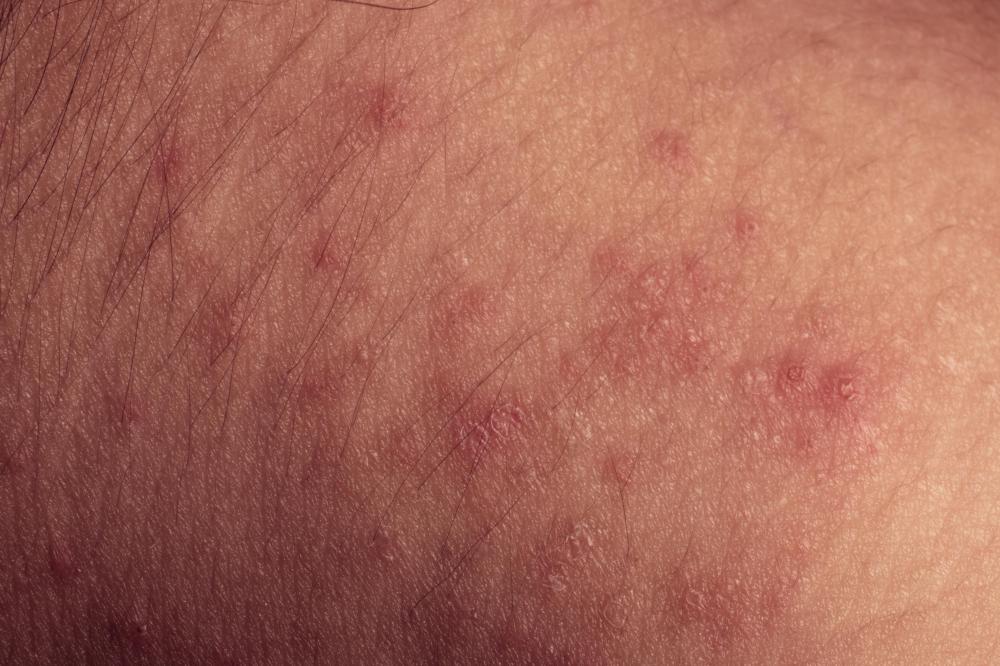At WiseGEEK, we're committed to delivering accurate, trustworthy information. Our expert-authored content is rigorously fact-checked and sourced from credible authorities. Discover how we uphold the highest standards in providing you with reliable knowledge.
What Are the Most Common Causes of Morbilliform Rashes?
Morbilliform rashes are types of rashes that resemble an outbreak of the measles. The most common causes of these skin rashes are drug interactions, viruses, and bacterial infections. Interactions with drugs are often delayed, occurring one or two weeks after the drug is in a person’s system, and are due to a sensitivity or allergic reaction. Viruses can cause a wide variety of symptoms, including a morbilliform rash. Bacterial infections, such as those that occur from a streptococcus infection, can lead to a rash as well.
A morbilliform rash is a type of maculopapular rash that appears on the skin. The eruptions are red colored and raised above skin level. Eruptions are often small, resembling pimples. They can be warm to the touch, itchy, and painful, depending on their location on the body.

Drug interactions are one of the common causes of these rashes. The rash occurs because the body either cannot process the medication properly or is sensitive and develops an allergic reaction. A reaction most commonly occurs after beginning treatment with antibiotic medications. Adults most often suffer from rashes due to a drug reaction because the body cannot tolerate the introduction of foreign materials. In many cases, a rash occurs from a drug reaction due to a conflict with other medications that results in a sensitivity developing that did not previously exist.

Morbilliform rashes can also be caused by a virus. In children, rashes that develop from viral infections are common. The virus can usually be identified. Roseola and rubella are viral diseases that are commonly identified in children. With rashes in adults with viral infections, the virus cannot usually be identified and the rash is called a non-specific viral morbilliform rash.

Bacterial causes are another possibility. Exposure to bacteria causes the immune system to respond. One of the symptoms that is possible with bacterial infections is a morbilliform rash. The body is exposed to the bacteria, the immune system tries to defend the body, and a wide variety of symptoms occurs. This type of rash often occurs on the chest or arms first and can spread further as the body continues to defend against the bacterial invasion.

Treatments for morbilliform rashes differ. The underlying cause of the rash must be identified and treated. Many doctors combine treatments for the condition, causing the rash and treatments to ease the symptoms of the rash as well. Corticosteroids, in oral or topical forms, are effective in reducing inflammation and itching. Antihistamines are also commonly used to treat these rashes.
AS FEATURED ON:
AS FEATURED ON:














Discussion Comments
There are quite a few disorders and diseases that can cause a morbiliform rash or a dermatology rash that is similar to morbiliform such as Kawasaki disease and Stevens Johnson syndrome. There is no reason to suspect serious conditions like these when a morbiliform rash occurs. I just want to point out that this type of rash does not only occur due to infections or drug reactions.
@SarahGen-- Yes, antibiotics can cause this type of rash. What type of antibiotic are you on? Did the rash start about a week after you started the antibiotics? Beta-lactam antibiotics are usually the culprit. If you're taking a penicillin group antibiotic, you can bet that that's the cause of the rash. These drug induced rashes usually don't show up right away. They take about a week to show up.
Do not stop taking anything before seeing your doctor about this. At least call him up right now and let him know about the rash. Although you should not use drugs that you have a sensitivity to, quitting antibiotics before treatment is over can worsen your infection and cause more complications. Your doctor will most likely switch you to a different group antibiotic that you are not sensitive to. Skin rash diagnosis requires tests and the doctor needs to see the rash. So see your doctor right away.
Which drugs usually cause a morbiliform rash? I have this type of measles like rash and the only medication I'm taking is an antibiotic for an ear infection.
Can the antibiotics cause this? If so, what should I do? Should I stop taking the medication?
Post your comments